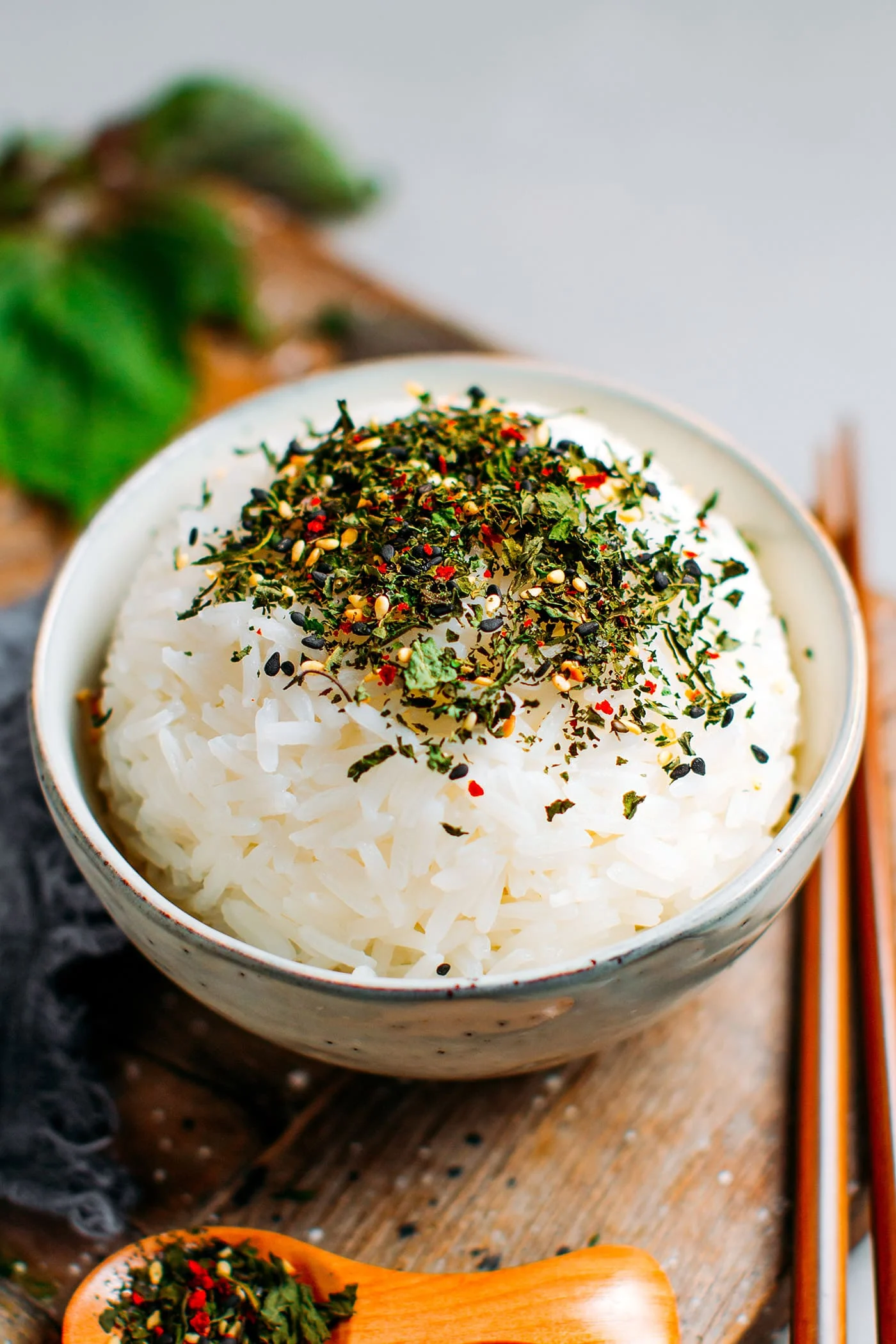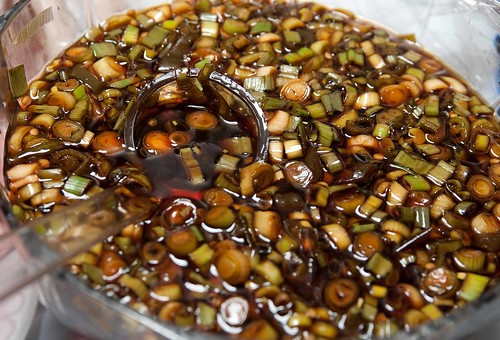F IS FOR FURIKAKE
By:
March 27, 2023

An installment in CONDIMENT ABECEDARIUM, an apophenic food-history series from HILOBROW friend Tom Nealon, author of the seminal book Food Fights and Culture Wars: A Secret History of Taste (2016 UK; 2017 US); and also — here at HILOBROW — the popular series STUFFED (2014–2020) and DE CONDIMENTIS (2010–2012).
CONDIMENT ABECEDARIUM: SERIES INTRODUCTION | AIOLI / ANCHOVIES | BANANA KETCHUP / BALSAMIC VINEGAR | CHIMICHURRI / CAMELINE SAUCE | DELAL / DIP | ENCURTIDO / EXTRACT OF MEAT | FURIKAKE / FINA’DENNE’ | GREEN CHILE / GARUM | HOT HONEY / HORSERADISH | INAMONA / ICE | JALAPEÑO / JIMMIES | KECAP MANIS / KIMCHI | LJUTENICA / LEMON | MONKEY GLAND SAUCE / MURRI | NƯỚC CHẤM / NUTELLA | OLIVE OIL / OXYGALA | PIKLIZ / PYLSUSINNEP SAUCE | QIZHA / QUESO | RED-EYE GRAVY / RANCH DRESSING | SAMBAL / SAUERKRAUT | TZATZIKI / TARTAR SAUCE | UMEBOSHI / UNAGI SAUCE | VEGEMITE / VERJUS | WHITE GRAVY / WOW-WOW SAUCE | XO SAUCE / XNIPEK | YOGHURT / YEMA | ZHOUG / ZA’ATAR | GOOD-BYE TO ALL TZAT(ZIKI).

Furikake, the Japanese powdery umami flavoring mixture used, mostly, on rice has a winding history through the 20th century. It was originally conceived as a calcium supplement in 1920s Japan; mixed with seaweed and the newly invented MSG additive, it became a popular topper for white rice. Though it was originally made with crushed-up fish bones (in fact, the fish bones were the whole point), they have disappeared over the years to be replaced by myriad sophistications: bonito, sesame seeds, shiso. The condiment’s wide-ranging popularity was no doubt helped by its beginning as a luxury good of sorts, as white rice was not always available to regular folk in early/mid century Japan. Now there are variations on variations — more fish flavors (salmon, tuna), curry, egg, nori, wasabi, and a wide range of spices.
Here in the U.S. we embraced umami late and still think of it as a single quality (like salty), but in Japan they throw 3, 4, 5 different umamis into a powdered rice topping, surrounding our tastebuds with savoriness. We usually think of “hot” the same way, a singular quality that a dish either has or doesn’t in some quantity, though it seems like we are slowly moving towards more subtle view of both umami and “spicy”.
Am I sure it’s a condiment, though? Mostly. While it has many of the characteristics of a flavoring or a season salt, I think it falls on the condiment side of the line. It’s basically always user-controlled (versus chef-controlled), isn’t widely used as an ingredient (like, for example, sazón) and has a more complex flavor profile than season salts like adobo, Old Bay, Lawry’s (or the product based ones like Big Boy’s, Bojangles, Old Vienna’s — though some of these could make their own case for being a condiment).
If you’ve got the right grocery store nearby, it’s easy enough to make your own furikake variety. Dulse and nori are readily available and I bet there are many other seaweeds and algaes that would be suitable for grinding up and adding to sesame, chile powder, msg, bonito, dried fish sauce, horseradish, or whatever else you like.

Before the Spanish arrived, the Chamorro people of Guam had a general-use condiment made of salt, local spices, citrus, and (probably) coconut vinegar and/or oil that they called finadene. (Fina’denne’ is how it’s typically spelled these days.) They used it on the abundant seafood but also the large local bats called flying foxes which were an occasional delicacy. It was used with and alongside the vegetable side of the diet which included taro, breadfruit, yam, banana, sugar cane and rice, some of which were indigenous (taro, breadfruit, yam) and some brought with the original inhabitants when they set sail from the mainland around 2000 BCE or in subsequent waves shortly thereafter.
When Magellan pulled up in 1521 — playing big-shot with his fleet to people who had sailed there 3500 years before — starving and desperate to trade for provisions, this is what they would have eaten. The Spanish did their overwhelming-force colonial thing shortly after — they dictated crops, brought in pigs and chickens, corn and cassava — and the Guamanian diet changed. It changed gradually — they were, by all accounts, pretty happy with what they were eating. There is even evidence that they (like most of the people who spread via boat throughout the South Pacific) had brought pigs to the Mariana Islands, but they just didn’t eat them (or the local birds) much. But their diet, under pressure from new work and new agriculture and new trade, changed. They ate less starchy vegetables and fish and more meat. As a result, finadene changed — it was the go-to condiment for fish and the occasional giant bat, but you need something much different for pig. They added soy sauce and different (and more) vinegar — not necessarily because these things were so much better than what they had, but because their diet was so different. They added chile peppers because… well, these they probably only added because they are awesome, but, still, you get the idea.
It’s happened throughout history — dietary changes make for condiment changes, which reinforce the diets, and on and on. The English got themselves into a spot for about 150 years where they only ate sausages with HP Sauce and toast. In Ancient Rome they were so prosperous that they ended up putting fish sauce on half their food and a sweet condiment made of vinegar and lead called “sugar of lead” on the other half. These diet-condiment feedback loops have consequences. The French invented hollandaise sauce in 1651 and almost crashed their economy with the great egg shortage of 1657. More recently, everyone remembers what happened with ranch dressing and salad bars. In many ways we are still living in the wreckage of those choices.
It is really hard to go back after you change your condiments. Sure, fina’denne’ tastes great — it’s a great condiment, like Filipino adobo had a baby with bbq sauce and put chile peppers in the crib — but condiments can be both great and a one-way street. You can’t put this on bat or parrot fish or one-eyed scad, clams or sea urchin. They say “give someone a bottle of ketchup and the whole world begins to look like a french fry” but if you force someone to just eat french fries and they cleverly invent ketchup, what then?
Still, it’s really good! Soy, vinegar, onion, chile peppers (usually the local “boonie peppers” which are similar to bird’s eye chiles and sometimes versions with fish brine. They also, naturally, make a lemon-centric version of fina’denne’ for putting on fish that is somewhat similar to Vietnamese nước chấm — often the two fina’denne’ types are separated as black and white fina’denne’, the one for pork and the other for fish. This stuff is really complicated, after all.
TOM NEALON at HILOBROW: CONDIMENT ABECEDARIUM series | STUFFED series | DE CONDIMENTIS series | SALSA MAHONESA AND THE SEVEN YEARS WAR | & much more. You can find Tom’s book Food Fights & Culture Wars here.
